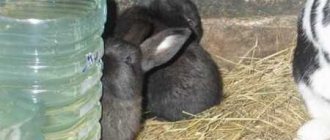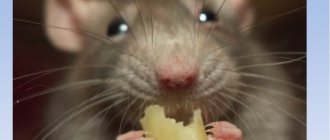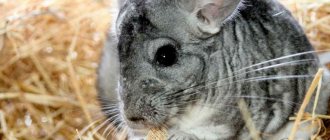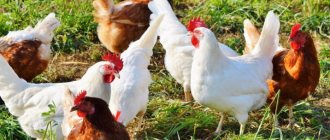Rats make amazing pets. It is not surprising that their owners do everything to ensure that the animals live longer. And the basis of rat well-being is not only good living conditions, but also proper feeding.
Previously, people didn’t think much about what they fed their pet rats. It's a rat! They are omnivores, indestructible, can eat soap, cardboard and sawdust, so why bother with them... As a result, the rats received either a “hamster diet” consisting of a single grain mixture, or a “pig ration” - they were simply given everything from the table. Both approaches are fundamentally wrong.
Properly feeding a rat is not so difficult, you just need to avoid harmful foods and try to maintain a balance of proteins, fats, and carbohydrates. Author of the article: Olga Shiltsova, practicing veterinarian, author of the books “Dachshund of Fate” and “Tails of Fortune”
What do you feed domestic rats: diet composition
A high-quality grain mixture is the basis of the diet of domestic rats. The easiest way is to choose ready-made high-quality food rather than making the mash yourself. Food is given ad libitum, without restrictions. An adult rat eats about 30 grams per day.
In addition to grain, the rat menu must include succulent food - vegetables or fruits, green salads. Protein complementary foods are also needed, especially for young animals during the growth period, pregnant or lactating females.
As a reward for training and just to pamper your pets, they use various seeds and nuts, unsweetened popcorn, banana chips and much more. Treats should make up a tiny part of the diet.
Why does it smell so good?
Domestic rats are fed something like this:
- 60% grain mixture (feed)
- 20% vegetables and unsweetened fruits, greens
- 10% protein food (meat, eggs)
- 5% fermented milk products
- 5% treats
Example of a diet for rats: dry food on the right, protein and succulent food on the left
Now let's take a closer look at each section.
Peculiarities of nutrition of little rat pups
For the first month after birth, little rat pups feed on their mother’s milk, which after a while is replaced by the food that these animals are accustomed to. The participation of the breeder in the process is practically not required, since the female rodent instinctively knows how to raise babies.
If there are too many offspring, the rat does not have time to look after them all. Then the weakest and most helpless are eliminated through natural selection. For someone who knows what little rat pups eat, it will not be difficult to raise them.
At first, the main food for rat cubs is milk and its derivatives, which are high in vitamins, fats, and beneficial minerals. The best option is dog milk, which, in its absence, can be replaced with goat milk. In addition, small rat pups can be fed with special mixtures.
Important: the transition to artificial nutrition must be carried out smoothly, strictly following the attached instructions, which will prevent oversaturation. Before using the mixture, the water-alkaline balance in babies is restored by taking appropriate medications (for example, Regidron).
- For the first 14 days, feeding is carried out around the clock with a break of 2-3 hours. For 10 gr. weight, the baby needs 0.5 ml of the mixture, which must be prepared before each meal.
- Grown-up rat pups are fed less frequently - every 4 hours, adding low-fat cottage cheese and a little cereal flour to the mixture.
- From the 4th week, rodents can be switched to adult food, but this must be done gradually, without overloading the body.
The scheme for introducing food familiar to rats into the diet of babies is as follows:
- allow the cub to smell and lick new food. You can use a slice of fruit, a boiled egg or a steamed (boiled) vegetable.
- Replace one meal completely with the indicated products, after finely chopping them.
- The next step is to include grains in your diet.
- By the end of the first month of life, the mixture should be completely abandoned, replacing it with other products. However, the baby should be given fermented milk products once a day.
Please note: after taking the mixture, the baby must be given specialized medications to avoid intestinal disorders.
Rat food: which one is better?
Grain mixture is the basis of the diet of domestic rats. I advise you to buy only high-quality food, and if this is not possible, prepare the mixture yourself. Unfortunately, domestic inexpensive food has a very poor composition. They consist mainly of oats.
I categorically do not recommend buying food that is stored in cardboard boxes (not airtight), especially in hypermarkets. A rat can easily be poisoned by such food if it was standing, for example, next to washing powder. Opt for imported food in sealed packaging.
Of the two foods, the choice is obvious in favor of Little One, although this is far from the best food for rats
Here are some high-quality foods that can be safely offered to decorative rats:
- Versel-Laga Rat Nature;
- Vitacraft Menu Vital;
- Beaphar Xtra Vital Rat or Care+ Rat Food;
- Vitapol Karma Premium;
- JR Farm Ratten-Schmaus.
Please note that in addition to regular grain mixtures, there are granulated foods for rats. They are similar to complete food for cats and dogs - homogeneous solid “crackers”. Granular feed does not differ from regular feed in composition. They are convenient in the case of selective eating - if rats select seeds and other goodies from the food, leaving the grain uneaten.
Rat food
The basis of the diet should always be cereals: wheat, rye, barley, oats.
Basic principles of feeding
As for food portions, there should be moderation in everything. You should not overfeed a decorative rat, as this can lead to unnecessary excess weight. If your pet leaves a lot of food in the cage, you need to reduce the amount.
Try not to give your rat everything you eat yourself. There are specialized feeds that contain all the necessary components of plant and animal origin.
Considering that these animals are predominantly nocturnal inhabitants, they need the main portion of food in the evening. In general, they are provided with 2 meals a day - morning and evening.
Don't forget to include something hard in your diet so that your rats have the opportunity to wear down their growing teeth.
What fruits and vegetables can rats eat?
Juicy food should be present in the rat menu every day. You should give preference to vegetables and leafy salads; these are healthy and low-calorie foods. Fruits and berries contain a lot of sugars; they are used more as a delicacy.
Rat eats peach slices, blueberries and green beans
You need to feed juicy foods to rats without fanaticism. From a large amount of greens, rat feces become soft and smelly, and even diarrhea is possible. The daily norm is determined individually.
How to give fruits and vegetables to rats:
- Peel the peel;
- Provide local, seasonal fruits;
- Approximate amount per day – 30 g per rat;
- Monitor your stool and well-being, introduce new types of fruits gradually.
In general, it’s better to stick to the “if you’re not sure, don’t give” rule. If one day the rat does not receive succulent food, there will be no trouble.
The following vegetables are fed to rats:
- Zucchini;
- Cucumber;
- Carrot;
- Pumpkin;
- Green salads: arugula, chard, corn, spinach;
- Celery;
- Spicy herbs: dill, parsley, basil.
Excellent assortment: zucchini pieces, lettuce, seeds
What fruits can you give to rats:
- Apricots;
- Bananas;
- Mango;
- Peaches;
- Apples.
In addition to vegetables and fruits, rats enjoy eating berries. However, this is precisely a delicacy, since such fruits contain a huge amount of sugar. Allowed berries:
- Strawberries or wild strawberries;
- Blueberries, blueberries;
- Cherry, sweet cherry;
- Currant;
- Raspberries.
Before giving your rat a new fruit or vegetable, make sure it is not on the list of prohibited foods. Also remember that rats, like people, have food allergies.
Origin
The white rat is an albino form of the gray domestic rat (pasyuk). White albino rats began to be bred at the beginning of the last century in laboratories for scientific experiments. This line of albino laboratory rats gave rise to many other laboratory rat lines (not just albino ones). It is believed that the first ornamental tame rats were obtained from this line by crossing with gray rats. From the white rat, animals were obtained that were black, brown, cinnamon, cream, sepia, silver, and blue.
White lab rats have been bred to have different characteristics: some have special behaviors, such as eating rats that dance; others are distinguished by their coat - long-haired, with a crest (capuchins) and curly hair.
Currently, rats are bred in large numbers in special nurseries and used for various scientific experiments. White rats have a similar genome to humans - the same set of 46 chromosomes. Therefore, white rats are widely used for research in genetics, microbiology, virology, toxicology, and radiobiology.
The results of experiments that scientists share with the general public indicate the extraordinary mental abilities of white rats. White rats are able to sympathize and empathize with other individuals; there are known cases of altruism among white rats.
Can rats eat meat: about protein feeding
Unlike rabbits or guinea pigs, rats are omnivores. A strictly vegetarian diet is bad for their well-being. Adult rats should be given protein-rich food 1-2 times a week, while young rats up to 5 months old should receive it 3-4 times a week.
Many people ask whether rats can eat meat, because they fear that the animal will become “bloodthirsty”, bite fingers, bite a cat, and the like. All these fears are groundless, rats do not become aggressive from meat, and it is necessary to give it. Although rats are delighted with such food, moderation must be observed - a serving of animal protein for an adult rodent is about 20 grams.
Juicy and protein complementary foods in one bowl
The following are used as protein foods:
- Lean boiled meat (beef, turkey, chicken, rabbit)
- Boiled eggs (quail or chicken);
- Boiled fish, squid or shrimp;
- Live and dried insects: grasshoppers, gammarus, zofobas, mealworms.
It is better to give out the meat individually so that the rats do not fight over the tasty morsel. Otherwise, particularly arrogant rats will receive protein overfeeding, while others will experience a lack of nutrients. They serve strictly boiled, not raw meat.
When there are a lot of rats: everyone gets a chicken leg!
As for eggs: boiled yolk can cause a rat to choke. To avoid this, boil the egg soft-boiled or mix the yolk with water. Quail eggs can be given unshelled; rats will eat or peel the shell at their discretion.
Quail eggs are given to rats not because of some “magical properties”, but because of their convenient size
Fish and seafood are rarely given, since these products give urine an unpleasant, specific odor.
Opinions differ regarding insects - there are fears that they can serve as a source of helminthic infestation. However, this is only true for live worms; dried insects are safe. For my part, I agree that it is easier and safer to give your pets a boiled quail egg or a piece of breast than to look for and buy all sorts of larvae.
Description
Rats have an oval body shape and a stocky build, characteristic of most rodents. The body length of an adult rat ranges from 8 to 30 cm (depending on the species), the weight of the rat varies from 37 g to 420 g (individual gray rats can weigh up to 500 grams).
The rat's muzzle is elongated and pointed, its eyes and ears are small. The tail of most species is practically naked, covered with sparse hairs and ring scales. The black rat's tail is covered with thick fur. The length of the tail of most species is equal to the size of the body or even exceeds it (but there are also short-tailed rats).
The rodent's jaws contain 2 pairs of elongated incisors. Rat molars grow in dense rows and are designed for grinding food. Between the incisors and molars there is a diastema - an area of the jaw where teeth do not grow. Despite the fact that rats are omnivores, they are distinguished from predators by the absence of fangs. Animals' incisors need constant grinding, otherwise the rat simply will not be able to close its mouth. This feature is due to the absence of roots and the continuous growth of the incisors throughout the life of the animal. The front of the incisors are covered with hard enamel, but there is no enamel layer at the back, so the surface of the incisors is ground unevenly and takes on a characteristic shape reminiscent of a chisel. The teeth of rats are extremely strong and can easily gnaw through brick, concrete, hard metals and alloys, although they were originally intended by nature to eat plant foods.
Rats have poorly developed calluses on their paws, which are necessary for rodents to climb, but the functional deficiency is compensated by mobile fingers. Therefore, rats are capable of leading not only a terrestrial, but also a semi-arboreal lifestyle, climbing trees and making nests in abandoned hollows.
Rats are very active and resilient animals, they run well: in case of danger, the animal reaches speeds of up to 10 km/h, overcoming obstacles up to 1 meter high. A rat's daily exercise ranges from 8 to 17 km.
Rats swim and dive well, catch fish and can continuously stay in water for more than 3 days without harm to their health. Rats' vision is poor and has a small viewing angle (only 16 degrees), which forces the animals to constantly turn their heads. Rodents perceive the world around them in shades of gray, and the color red represents complete darkness for them.
Hearing and smell function well: rats perceive sounds with a frequency of up to 40 kHz (for comparison: humans up to 20 kHz), and detect odors at short distances. But rats tolerate the effects of radiation very well (up to 300 roentgens/hour).
The lifespan of a rat in the wild depends on the species: gray rats live about 1.5 years, rare specimens can live up to 3 years, black rats live no more than a year. In laboratory conditions, the life of a rodent increases by 2 times. According to the Guinness Book of Records, the oldest rat was 7 years and 8 months old at the time of death.
Can rats have milk?
Many rats love fermented milk products. They can also be considered as a source of animal protein, calcium and other benefits. However, many rats cannot digest lactose due to a lack of the enzyme lactase. Dairy products cause strong fermentation in their intestines, and as a result - bloating and diarrhea.
Rats are strictly not given whole milk, as well as dairy products that are too fatty (10-20% sour cream, cream). The best option is fermented milk products with a fat content of up to 5%, without flavorings or any additives. They should not be sweet.
Rats can be given as treats (a dessert spoon of each):
- Cottage cheese;
- Natural yogurt;
- Ryazhenka, acidophilus, narine.
If your pet has not received dairy products before, you need to start with small portions and monitor how you feel afterwards. Fermented milk is given on days when rats do not receive protein complementary foods (meat, eggs), either separately or as a reward.
The clever thief was attracted by the remains of milk at the bottom of the glass
Must-have products
What to feed a decorative rat? It is important that the rodent menu is balanced. It should contain the optimal ratio of vitamin and mineral elements that are required to maintain health.
If you are thinking about what to feed your pet rat, then the following list of products will help you deal with this problem:
- Vegetables, greens, fruits, berries. These natural products are an important part of the diet of these living creatures. The fact is that these plant components contain an increased level of nutrients, microelements, and they contain fiber, which is required for the normal functioning of the digestive system. Be sure to give the rat carrots, cabbage, turnips, and potato tubers. It is recommended that they eat them boiled. They can eat any fruit, but without seeds. Among the greens in the diet, you can include lettuce leaves, sprigs of parsley, celery, dill, clover leaves, plantain, and dandelion.
- Meat and fish products. In addition to plant products, the rodent menu must include meat and fish. But they should be given to your pet more often 2-3 times every 7 days. These products should only be given boiled, but not raw or fried. You can also add offal to the menu - heart and liver.
- Cereals. Cereals are the main source of carbohydrates. They can be given in grain form or sprouted. In sprouted form, they are considered the most useful because they contain a high content of vitamin E, which is required for the normal functioning of the immune system. The list of grain feed should include the following varieties of crops: millet, rye, oats, barley.
- Nuts. They have an increased level of protein, but should be given in limited quantities. But you should completely avoid almonds.
- Be sure to include dried fruits in your pet’s menu – prunes, dried apricots, raisins.
- Dairy products. Rodents love to eat cheese, low-fat cottage cheese, and also drink skim milk, kefir, and natural yogurt, but it should not contain additives or dyes.
- Hard-boiled eggs. They are given not so often, no more than once every 7 days.
- You can feed your white pet with chalk, which has a high calcium content. You can also use yeast and charcoal. In winter, it is worth giving vitamins that can be purchased at a pet store.
Important! Rats should be fed regularly. Your pet should eat well, but it is important that it does not overeat, otherwise obesity may occur, which can negatively affect the pet’s health.
Treats for rats: a little of each
Training animals is incredibly interesting; rats successfully learn various commands. The question arises - how to encourage pets so as not to harm them. And in everyday life, sometimes you want to pamper rats with something tasty.
The main rule: the treat should not be sweet. Therefore, I urge you not to buy “treats” for rodents at the pet store! Milk drops, honey sticks and other crap can be harmful to the health of rats. Moreover, no less tasty things can be found at home.
This cookie is obviously too big
Rats love seeds and nuts! They are given individually, literally one at a time, 1-2 times a week. The point is high fat content and calorie content. Seeds and nuts should not be fried or salted.
- Watermelon, pumpkin, sunflower, flax seeds, sesame seeds;
- Walnuts, hazelnuts, cashews, peanuts.
Rats love all kinds of seeds, but this is too fatty food for them
As a reward, you can use treats made from cereals and cereals:
- Pieces of cereal, unless they are sweet (corn, wheat);
- Tiny crackers dried from regular bread;
- Unsweetened cookies (biscuits);
- Homemade popcorn or puffed rice;
- Pieces of rice paper;
- Pasta;
- Porridges from various cereals.
For repeated rewards, you can dip a stick in yogurt or baby puree and let your rat lick it.
Dumbo rat eats corn
What should you not feed your pet rat?
Any products containing salt, sugar, spices, dyes, flavors and preservatives are contraindicated for rats. Therefore, most “human” food is not suitable for them. Chips, sausage, sweets, alcohol, smoked or pickled foods are prohibited.
If mommy eats a cupcake, that's right - we eat a cupcake too!
Foods prohibited due to high fat content (rats have weak livers):
- Sour cream, cream, condensed milk;
- Cheese (yes, cheese is strictly prohibited);
- Lard, bacon;
- Oil.
You should not give vegetables that contain a dangerous toxin - solanine, that is, from the nightshade family:
- Tomatoes;
- Eggplant;
- Bell pepper;
- Potato.
Boiled potatoes can be given, but only occasionally due to their high starch content. There is no point in such a “delicacy”.
You should not give fruits and vegetables that cause gas in the intestines. Such products can be really dangerous for rodents:
- Beans, beans, peas;
- Radish;
- Cabbage;
- Radish;
- Broccoli;
- Turnip;
- Radish (daikon);
- Pears;
- Dried fruits.
Causes intestinal upset (diarrhea):
- Beet;
- Plums.
Fruits that contain large amounts of acids are also contraindicated for rats:
- Any citrus fruits (tangerines, oranges, grapefruits, pomelo);
- Kiwi;
- A pineapple.
Be careful when feeding melons and watermelons to rats due to their high sugar content and the possibility of nitrate poisoning.
You should not give pits containing hydrocyanic acid (apricots, plums, cherries); for the same reason, rats are not given almonds.
Be careful during lunch: if rats are nearby, the game “Give me a piece, man!!!” begins.











